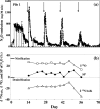Source of nitrous oxide emissions during the cow manure composting process as revealed by isotopomer analysis of and amoA abundance in betaproteobacterial ammonia-oxidizing bacteria
- PMID: 20048060
- PMCID: PMC2832385
- DOI: 10.1128/AEM.01394-09
Source of nitrous oxide emissions during the cow manure composting process as revealed by isotopomer analysis of and amoA abundance in betaproteobacterial ammonia-oxidizing bacteria
Abstract
A molecular analysis of betaproteobacterial ammonia oxidizers and a N(2)O isotopomer analysis were conducted to study the sources of N(2)O emissions during the cow manure composting process. Much NO(2)(-)-N and NO(3)(-)-N and the Nitrosomonas europaea-like amoA gene were detected at the surface, especially at the top of the composting pile, suggesting that these ammonia-oxidizing bacteria (AOB) significantly contribute to the nitrification which occurs at the surface layer of compost piles. However, the (15)N site preference within the asymmetric N(2)O molecule (SP = delta(15)N(alpha) - delta(15)N(beta), where (15)N(alpha) and (15)N(beta) represent the (15)N/(14)N ratios at the center and end sites of the nitrogen atoms, respectively) indicated that the source of N(2)O emissions just after the compost was turned originated mainly from the denitrification process. Based on these results, the reduction of accumulated NO(2)(-)-N or NO(3)(-)-N after turning was identified as the main source of N(2)O emissions. The site preference and bulk delta(15)N results also indicate that the rate of N(2)O reduction was relatively low, and an increased value for the site preference indicates that the nitrification which occurred mainly in the surface layer of the pile partially contributed to N(2)O emissions between the turnings.
Figures





Similar articles
-
Differences in distribution of functional microorganism at DNA and cDNA levels in cow manure composting.Ecotoxicol Environ Saf. 2020 Mar 15;191:110161. doi: 10.1016/j.ecoenv.2019.110161. Epub 2020 Jan 15. Ecotoxicol Environ Saf. 2020. PMID: 31954219
-
Distribution and diversity of archaeal and bacterial ammonia oxidizers in salt marsh sediments.Appl Environ Microbiol. 2009 Dec;75(23):7461-8. doi: 10.1128/AEM.01001-09. Epub 2009 Oct 2. Appl Environ Microbiol. 2009. PMID: 19801456 Free PMC article.
-
Activity and composition of ammonia oxidizing bacterial communities and emission dynamics of NH3 and N2O in a compost reactor treating organic household waste.J Appl Microbiol. 2009 May;106(5):1502-11. doi: 10.1111/j.1365-2672.2008.04111.x. Epub 2009 Feb 4. J Appl Microbiol. 2009. PMID: 19210570
-
16S rRNA and amoA-based phylogeny of 12 novel betaproteobacterial ammonia-oxidizing isolates: extension of the dataset and proposal of a new lineage within the nitrosomonads.Int J Syst Evol Microbiol. 2003 Sep;53(Pt 5):1485-1494. doi: 10.1099/ijs.0.02638-0. Int J Syst Evol Microbiol. 2003. PMID: 13130037
-
Microbiology of nitrogen cycle in animal manure compost.Microb Biotechnol. 2011 Nov;4(6):700-9. doi: 10.1111/j.1751-7915.2010.00236.x. Epub 2011 Jan 6. Microb Biotechnol. 2011. PMID: 21375720 Free PMC article. Review.
Cited by
-
From the ground up: global nitrous oxide sources are constrained by stable isotope values.PLoS One. 2015 Mar 26;10(3):e0118954. doi: 10.1371/journal.pone.0118954. eCollection 2015. PLoS One. 2015. PMID: 25811179 Free PMC article.
-
Effects of operating parameters on in situ NH3 emission control during kitchen waste composting and correlation analysis of the related microbial communities.Environ Sci Pollut Res Int. 2019 Apr;26(12):11756-11766. doi: 10.1007/s11356-019-04605-4. Epub 2019 Feb 27. Environ Sci Pollut Res Int. 2019. PMID: 30815814
-
Growth of ammonia-oxidizing archaea and bacteria in cattle manure compost under various temperatures and ammonia concentrations.Microb Ecol. 2012 May;63(4):787-93. doi: 10.1007/s00248-011-9971-z. Epub 2011 Nov 10. Microb Ecol. 2012. PMID: 22072124
-
The effect of biochar prepared at different pyrolysis temperatures on microbially driven conversion and retention of nitrogen during composting.Heliyon. 2023 Feb 13;9(3):e13698. doi: 10.1016/j.heliyon.2023.e13698. eCollection 2023 Mar. Heliyon. 2023. PMID: 36873514 Free PMC article.
-
Microbial Abundances Predict Methane and Nitrous Oxide Fluxes from a Windrow Composting System.Front Microbiol. 2017 Mar 20;8:409. doi: 10.3389/fmicb.2017.00409. eCollection 2017. Front Microbiol. 2017. PMID: 28373862 Free PMC article.
References
-
- Agriculture, Forestry and Fisheries Research Council Secretariat. 1999. Japanese feeding standard for dairy cattle. Central Association of Livestock Industry, Tokyo, Japan.
-
- Avrahami, S., W. Liesack, and R. Conrad. 2003. Effects of temperature and fertilizer on activity and community structure of soil ammonia oxidizers. Environ. Microbiol. 5:691-705. - PubMed
-
- Bothe, H., G. Jost, M. Schloter, B. B. Ward, and K. Witzel. 2000. Molecular analysis of ammonia oxidation and denitrification in natural environments. FEMS Microbiol. Rev. 24:673-690. - PubMed
-
- Bremner, J. M. 1965. Total nitrogen; inorganic forms of nitrogen, p. 1149-1255. In C. A. Black (ed.), Methods of soil analysis, part 2. Soil Science Society of America, Madison, WI.
Publication types
MeSH terms
Substances
Associated data
- Actions
- Actions
- Actions
- Actions
- Actions
- Actions
- Actions
- Actions
- Actions
- Actions
- Actions
- Actions
- Actions
- Actions
- Actions
LinkOut - more resources
Full Text Sources
Molecular Biology Databases

